Introduction
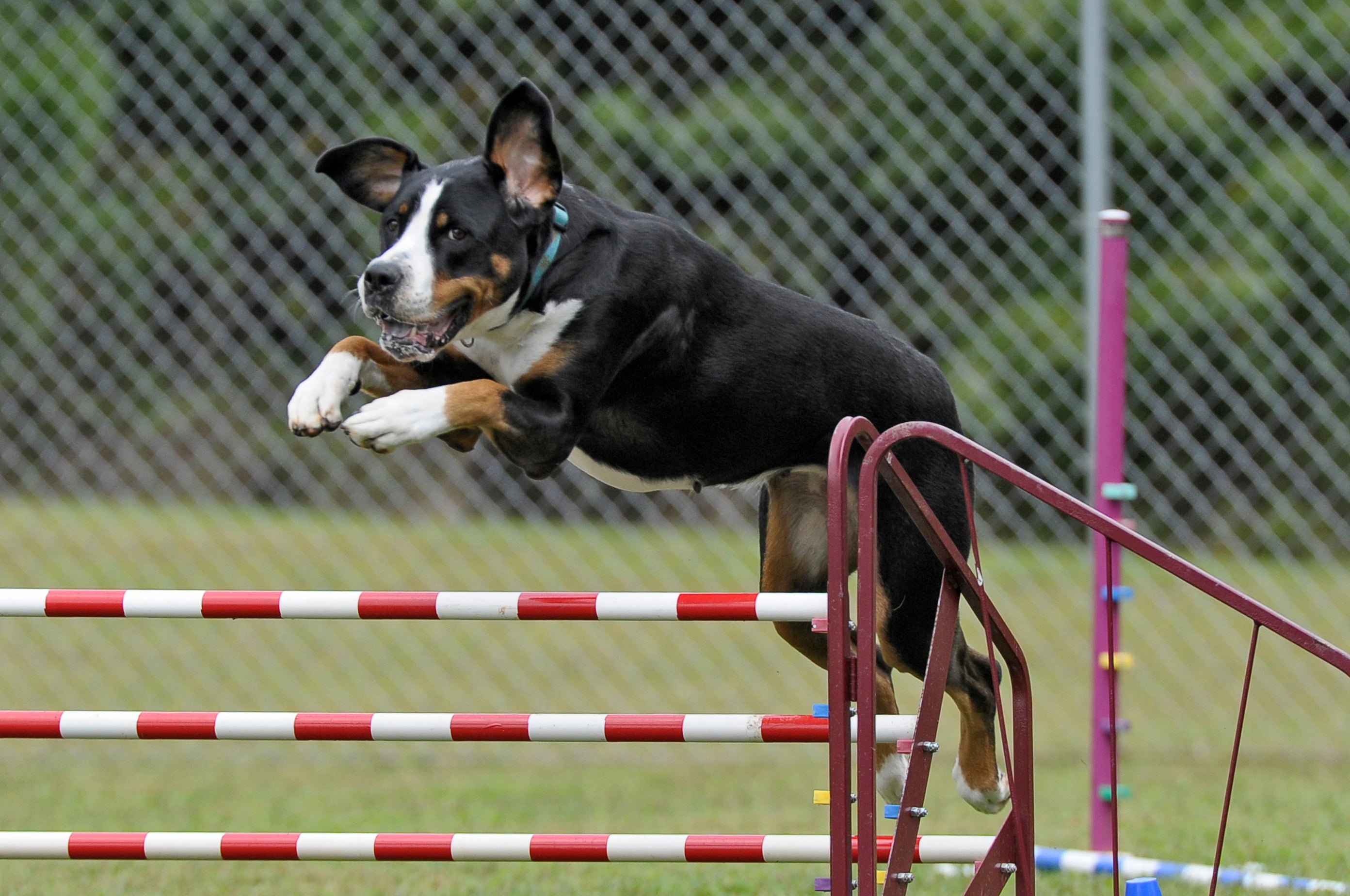
Introducing a world of exhilarating competition and teamwork, dog sports have captured the hearts of dog enthusiasts and owners around the world. From the thrill of agility courses to the precision of obedience trials, there are numerous avenues for dogs and their handlers to showcase their skills and strengthen their bond. Dog sports encompass a wide range of activities, each with its own unique rules and challenges. Whether it's the fast-paced action of flyball or the acrobatic displays of disc dog, there is a sport for every dog and handler duo. In this article, we will explore the different facets of dog sports and delve into the benefits of engaging in these activities. Let's uncover the exciting world of dog sports!
The Different Facets of Dog Sports
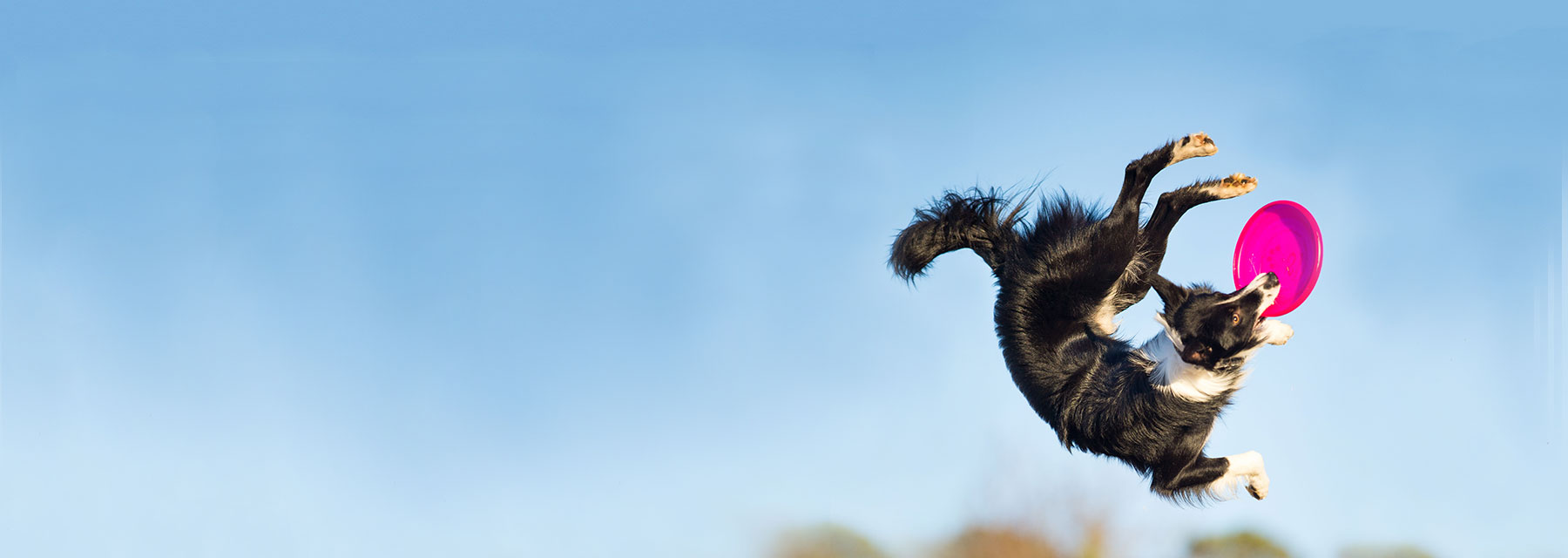
Dog sports encompass a wide range of activities that allow dogs and their owners to engage in fun and challenging competitions. From agility to disc dog, there are numerous facets of dog sports to explore.
One popular facet is agility, where dogs navigate obstacle courses with speed and precision. Obedience trials focus on training dogs to obey commands and perform specific tasks. Flyball showcases a dog's speed and agility as they race against other dogs in relay teams. Disc dog competitions highlight a dog's ability to catch flying discs with incredible skill and accuracy.
Dock diving tests a dog's jumping and swimming abilities, while rally obedience combines elements of obedience and agility. Lure coursing taps into a dog's natural hunting instinct as they chase after a mechanical lure.
With so many different facets to choose from, dog sports provide endless opportunities for dogs and their owners to bond, stay active, and have fun together.
Benefits of Engaging in Dog Sports

Engaging in dog sports offers a multitude of benefits for both dogs and their owners. First and foremost, participating in dog sports helps to promote a strong bond and connection between the dog and its handler. Through training and competing together, they develop a sense of teamwork and mutual trust.
Dog sports also provide excellent physical exercise for both dogs and their owners. Many sports, such as agility and flyball, require dogs to navigate challenging courses, which helps to improve their physical fitness and stamina. Likewise, handlers must be active and agile to keep up with their dogs during these activities.
Furthermore, dog sports offer mental stimulation for dogs, keeping their minds sharp and engaged. The training involved in dog sports stimulates problem-solving skills and enhances obedience and listening skills.
Additionally, participating in dog sports provides an opportunity for socialization. Competitions and training classes allow dogs to interact with other dogs and people, promoting proper social behavior and reducing fear or aggression towards unfamiliar animals.
Overall, engaging in dog sports is not only fun but also has numerous benefits, including improved physical fitness, mental stimulation, and enhanced socialization skills for both dogs and their owners.
Agility

Agility is a thrilling and fast-paced dog sport that showcases a dog's speed, agility, and obedience. In agility competitions, dogs navigate through a series of obstacles such as jumps, tunnels, weave poles, and A-frames in a specific order and under the guidance of their handler. The goal is to complete the course accurately and within the fastest time possible.
Agility training involves teaching the dog specific commands and techniques to successfully maneuver through each obstacle. Handlers use various training methods, including positive reinforcement and clicker training, to help their dogs learn and understand the desired behaviors.
To participate in agility competitions, dogs need to be physically fit, mentally focused, and well-trained. It is a great way for dogs and their owners to bond, exercise, and challenge themselves while having fun.
Overview of Agility as a Dog Sport

Agility is a popular and thrilling dog sport that tests a dog's speed, agility, and obedience while navigating through a designated course. The goal is for the dog and handler to complete the course in the fastest time with the fewest mistakes or faults. The Agility course typically consists of various obstacles such as jumps, tunnels, weave poles, A-frames, and seesaws, among others.
This fast-paced sport requires dogs to follow the handler's direction and perform the obstacles correctly. Precision, teamwork, and communication between the dog and handler are essential for success in Agility. Dogs of all breeds and sizes can participate in Agility, making it an inclusive sport for all canines.
Agility competitions are divided into different height categories to ensure fair competition among dogs of similar sizes. The scoring is based on speed and accuracy, with penalties for mistakes or knocked-down obstacles. Agility trials are an exciting and engaging experience for both the dogs and handlers, providing a platform to showcase their skills and training.
Training Techniques and Equipment Used in Agility
When it comes to agility training, there are various techniques and equipment that are used to help dogs develop the necessary skills and agility required for the sport. One commonly used technique is positive reinforcement, where dogs are rewarded with treats or praise for successfully completing an obstacle. This helps to encourage and motivate them throughout the training process. Additionally, clicker training is often used to mark desired behaviors and provide immediate feedback to the dog.
In terms of equipment, agility courses typically consist of jumps, tunnels, weave poles, A-frames, and seesaws, among other obstacles. These obstacles are designed to test the dog's speed, agility, and ability to navigate different types of challenges. Safety is also a priority, so handlers often use safety equipment such as harnesses and leashes to ensure the dog's well-being during training and competitions. Overall, these training techniques and equipment play a crucial role in giving dogs the foundation they need to excel in agility sports.
Obedience
Obedience trials are a popular dog sport that tests a dog's ability to obey a handler's commands. In these trials, dogs are evaluated on their response to basic obedience commands such as sit, stay, come, and heel. The goal is to assess their discipline and willingness to follow instructions. Obedience trials consist of various exercises, including off-leash commands and heeling patterns.
Handlers and their dogs must demonstrate a strong bond and clear communication during the trials. Judges evaluate not only the accuracy of the dog's performance but also their overall enthusiasm and attentiveness. Obedience training helps dogs become well-behaved and reliable companions, improving their behavior both at home and in public settings.
Engaging in obedience trials can strengthen the bond between dogs and their handlers while providing mental and physical stimulation. It is a rewarding sport that promotes good behavior and serves as a foundation for other dog sports such as agility and rally obedience. Through obedience trials, dogs can showcase their training achievements and their handler's dedication to their well-being.
Exploring Obedience Trials for Dogs
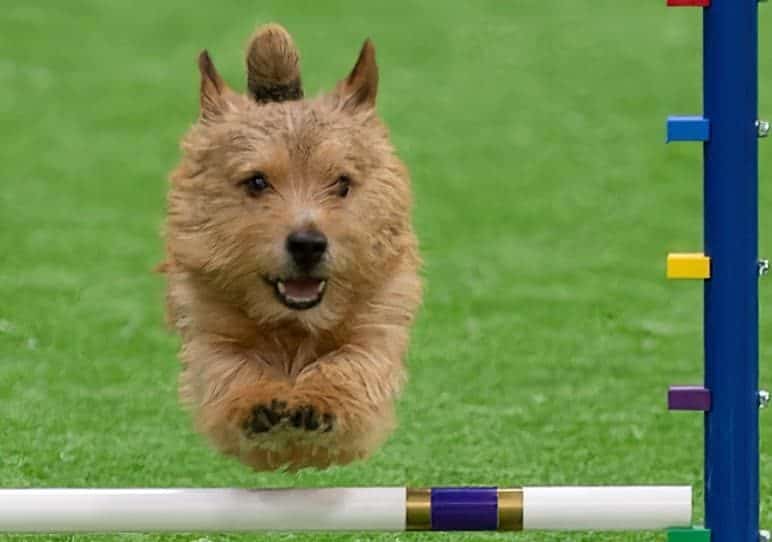
Obedience trials are a popular dog sport that puts a dog's training and obedience skills to the test. In these trials, dogs are required to perform a series of exercises and tasks, showcasing their ability to follow commands and demonstrate discipline. The purpose of obedience trials is to assess a dog's responsiveness and willingness to work with their handler in various situations.
During an obedience trial, dogs are judged on their ability to perform specific obedience exercises, such as heeling, sitting, staying, and coming when called. The judges evaluate the dog's accuracy, precision, and overall control. Obedience trials also often include additional exercises that demonstrate more advanced skills, such as retrieving objects or performing complex tricks.
Participating in obedience trials provides numerous benefits for both dogs and their owners. It not only strengthens the bond between the two but also helps dogs develop better focus, self-control, and responsiveness to their handler's commands. Obedience trials also offer an opportunity for dogs to showcase their training achievements and compete against other well-trained dogs.
To be successful in obedience trials, dogs require consistent training and reinforcement of obedience commands. Handlers must invest time and effort in teaching their dogs proper obedience skills. Positive reinforcement techniques, such as rewards and praise, are commonly used to encourage desired behaviors and motivate dogs to perform well during trials.
Furthermore, obedience trials require careful preparation and conditioning. Dogs should be well-socialized and able to work confidently in various environments and with distractions. Handlers need to familiarize themselves with the specific rules and requirements of the trials they wish to participate in, ensuring they understand the exercises and criteria for scoring.
In conclusion, obedience trials provide a platform to assess and showcase a dog's obedience and training skills. By participating in these trials, dogs and their owners can strengthen their bond, improve their obedience training, and enjoy the challenges and rewards that come with this dog sport.
Key Commands and Skills in Obedience Training
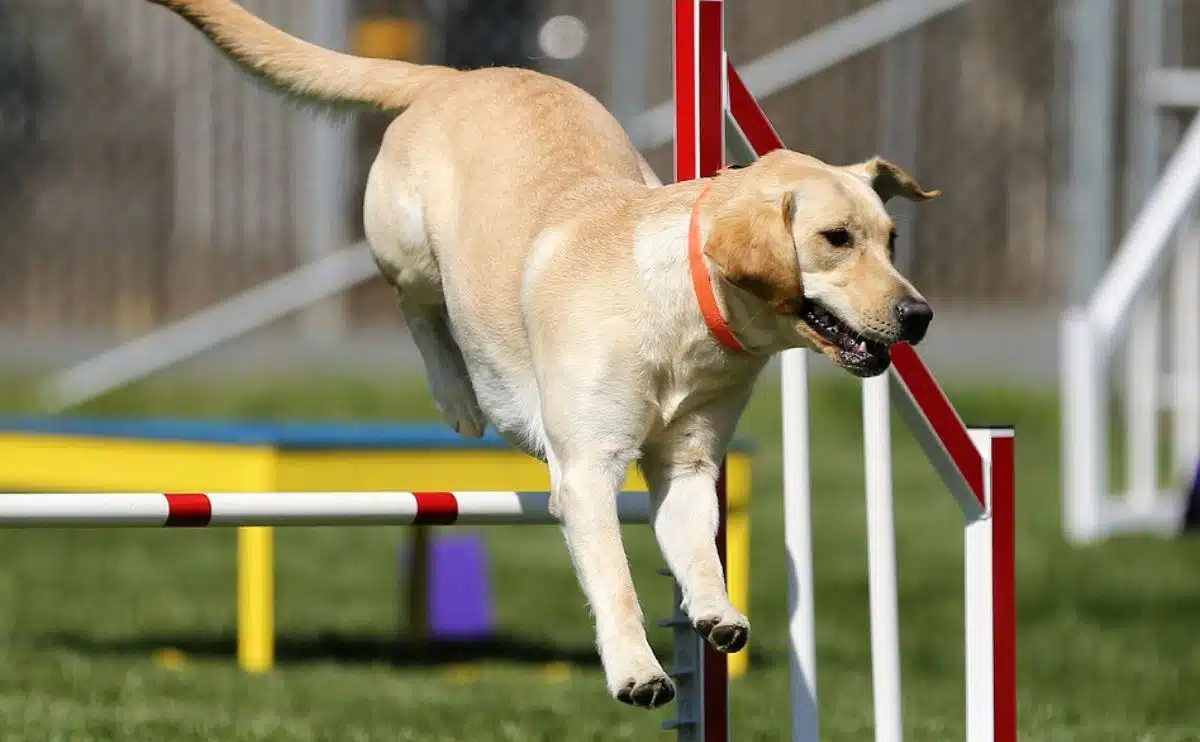
In obedience training, there are several key commands and skills that dogs are taught to master. These commands are essential for ensuring that dogs are well-behaved and responsive to their owners' instructions. One of the most basic commands is "sit," which involves teaching the dog to sit down on command. Another important command is "stay," which requires the dog to remain in a specific position until given permission to move. "Come" is another crucial command that teaches the dog to return to their owner when called. Additionally, commands like "heel" teach dogs to walk calmly and obediently beside their owners. These key commands and skills form the foundation of obedience training, ensuring that dogs become well-mannered companions.
Flyball
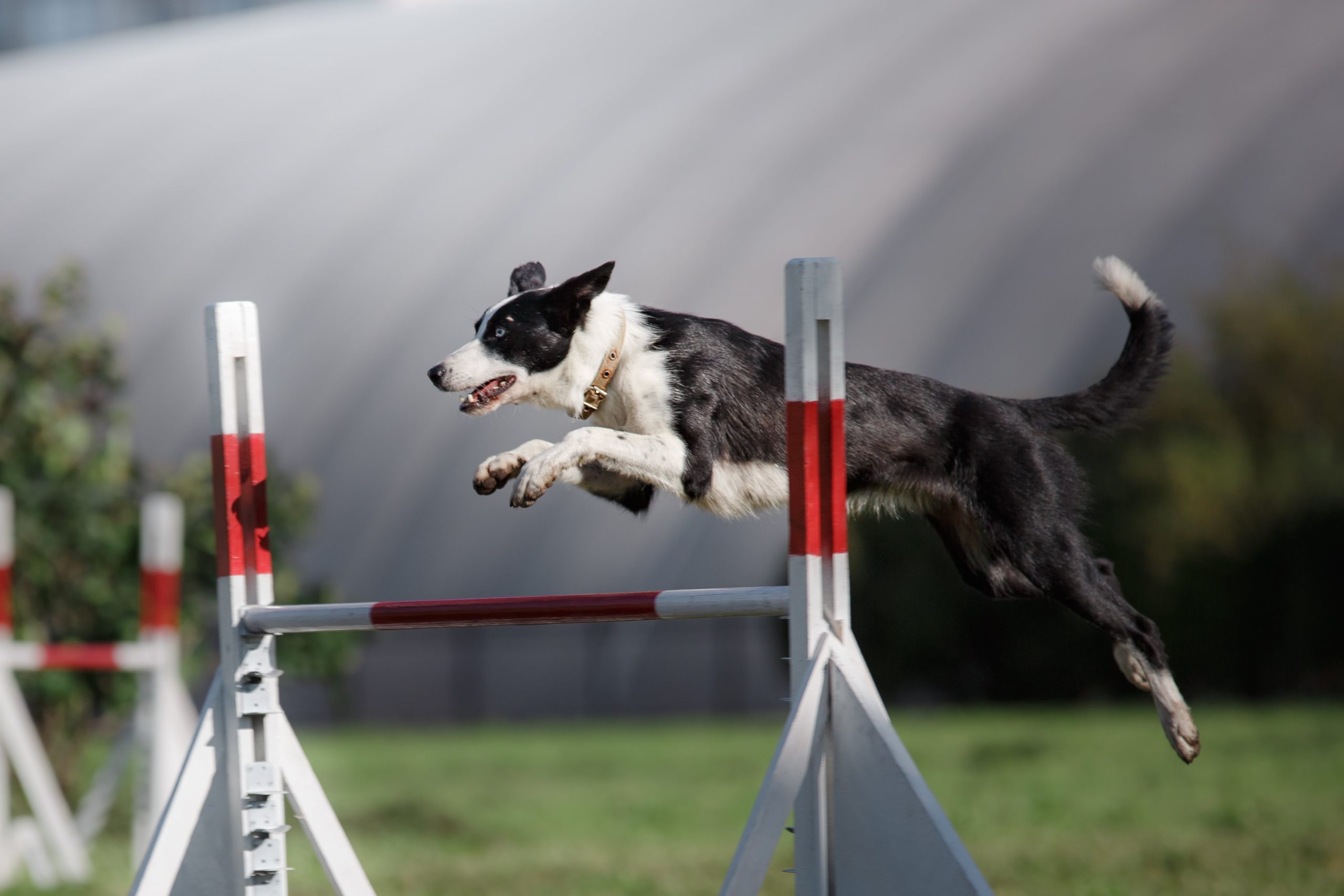
Understanding the Thrills of Flyball
Flyball is a fast-paced and high-energy dog sport that showcases the incredible speed and agility of our canine companions. It involves teams of four dogs racing against each other, taking turns to clear a series of hurdles and retrieve a tennis ball from a spring-loaded box. The objective is for the dogs to complete the course as quickly as possible, with flawless accuracy.
This exhilarating sport not only tests a dog's physical abilities but also their focus and teamwork. It requires dogs to have a strong desire to chase and retrieve, as well as a solid command of obedience skills. Flyball competitions are filled with excitement and cheers from the spectators as these dogs showcase their incredible speed, agility, and intelligence.
To excel in flyball, dogs need to have a strong bond with their human handlers and be trained in basic obedience commands. It is a sport that can be enjoyed by dogs of all breeds and sizes, as long as they have the desire and drive to chase a ball. Flyball provides an outlet for both mental and physical stimulation, making it a fun and fulfilling activity for both dogs and their owners.
Understanding the Thrills of Flyball
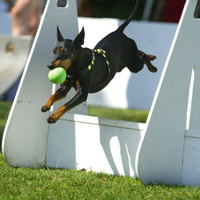
Flyball is a fast-paced and exhilarating dog sport that showcases speed, agility, and teamwork. The goal of flyball is for a team of dogs to race against each other, one at a time, over a series of hurdles to retrieve a ball from a designated box.
What makes flyball so thrilling is the incredible speed at which the dogs sprint down the course. They launch themselves over the hurdles with seemingly boundless energy, fueled by their desire to reach the box and retrieve the ball as quickly as possible. The intense competition between teams adds to the excitement as spectators cheer on their favorite four-legged athletes.
The high-intensity nature of flyball makes it a thrilling spectator sport as well. The fast-paced action, combined with the camaraderie and teamwork between dogs and their handlers, creates an electrifying atmosphere that keeps everyone on the edge of their seats. Every race brings a new opportunity for dogs to showcase their skills and for teams to strive for victory. Whether you’re participating or watching, the thrills of flyball are sure to leave you captivated.
Flyball Equipment and Team Dynamics

Flyball is a fast-paced and thrilling dog sport that involves teams racing against each other. To succeed in Flyball, both the equipment and the team dynamics play crucial roles.
The equipment used in Flyball includes a set of hurdles, a Flyball box, and tennis balls. The hurdles are designed to be easily adjustable based on the height of the dogs competing. The Flyball box is a special contraption that releases the tennis ball when the dog steps on it.
Team dynamics are also vital in Flyball. Each team consists of four dogs and their handlers, who work together to achieve a seamless relay race. Effective communication between the handler and the dog, as well as synchronization between team members, is essential for a successful performance.
In Flyball, teams not only compete on speed but also rely on teamwork to achieve victory. The right equipment and a well-coordinated team can make all the difference in this exciting dog sport.
Disc Dog
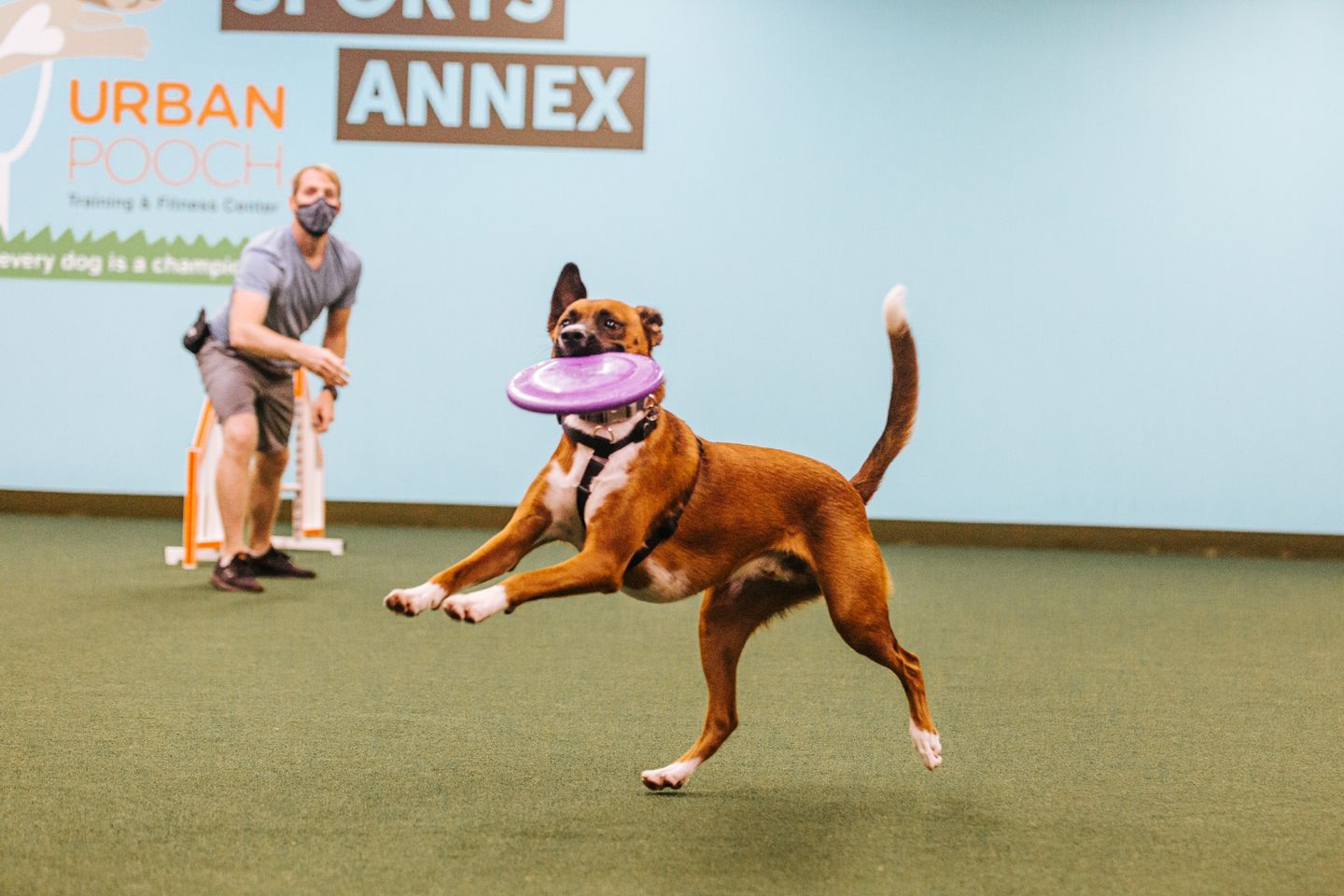
Disc Dog is a thrilling and captivating dog sport that showcases the incredible athleticism and coordination of dogs and their handlers. In Disc Dog competitions, dogs are trained to catch flying discs with impressive speed and agility. This high-energy sport requires precision, teamwork, and a strong bond between the dog and their handler.
Training a dog for Disc Dog involves teaching them to chase down the disc, catch it mid-air, and return it to the handler. It requires a combination of obedience training, agility skills, and a love for playing fetch. Handlers use various throwing techniques and strategies to challenge their dogs and showcase their abilities.
To succeed in Disc Dog competitions, handlers must focus on building a strong foundation of basic commands, such as sit, stay, and come. They also need to work on developing the dog's catching and retrieving skills. Positive reinforcement techniques, such as treats and praise, are used to encourage and motivate the dogs during training.
Disc Dog competitions are held in various formats, including freestyle routines and distance catching. In freestyle routines, handlers choreograph a routine set to music, incorporating a variety of throws, catches, and tricks. Distance catching competitions challenge dogs to catch the disc from increasing distances.
Disc Dog is a sport that not only provides physical exercise and mental stimulation for dogs but also strengthens the bond between dogs and their handlers. It is a great way for both dogs and their owners to have fun, stay active, and showcase their talents. So, if you have a dog with a strong prey drive and a love for fetching, Disc Dog might be the perfect sport for you both.
The Exciting World of Disc Dog Competitions
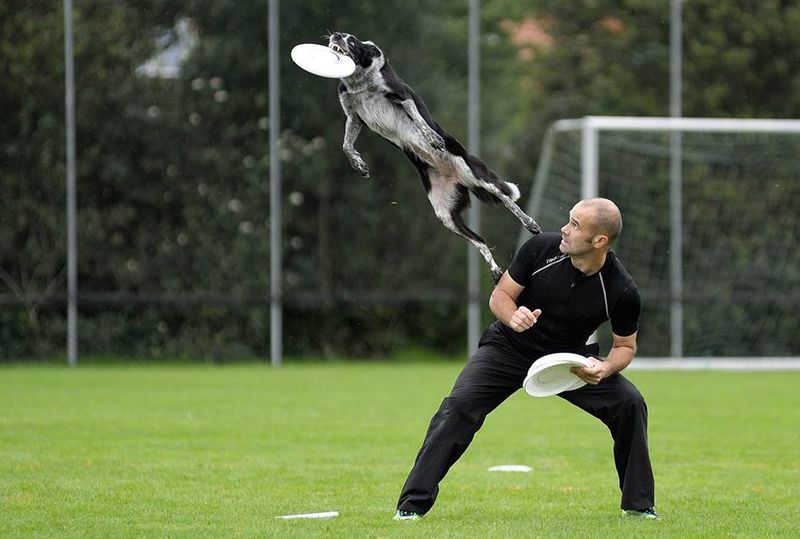
Disc dog competitions are a thrilling display of agility, precision, and teamwork between dogs and their handlers. These events showcase the dynamic sport of disc dog, also known as canine disc, where dogs perform gravity-defying catches and acrobatic maneuvers to chase and catch a flying disc.
In disc dog competitions, dogs are judged on various criteria such as distance, accuracy, difficulty of catches, and style. Handlers throw the discs with impressive skill and dogs showcase their athleticism as they leap, twist, and flip to catch the discs mid-air. The audience is left in awe as they witness the incredible bond and coordination between the dog and handler.
These competitions are not only a display of talent, but also create an exciting atmosphere where competitors and spectators can appreciate the beauty and athleticism of dogs. It’s a sport that brings together dog lovers, athletes, and enthusiasts to celebrate the incredible abilities of our four-legged companions.
Training Tips for Disc Dog Success

Training Tips for Disc Dog Success
To excel in disc dog competitions, a solid training foundation is paramount. Here are some tips to help you and your dog become a successful disc dog team.
- Start with basic obedience: Ensure that your dog has a strong foundation in obedience commands such as sit, stay, and recall. These skills create the groundwork for more advanced disc dog training.
- Introduce the disc gradually: Begin by letting your dog become familiar with the disc and associate it with positive experiences. Use treats and praise to reward your dog for showing interest in the disc.
- Teach proper catching techniques: Focus on teaching your dog to catch the disc softly and safely. Start with short throws and gradually increase the distance. Use positive reinforcement to reward successful catches.
- Incorporate fetch and retrieve: Encourage your dog to bring back the disc after catching it. Use positive reinforcement to reinforce the retrieve behavior.
- Practice different throws and tricks: Experiment with different types of throws, such as backhand and sidearm, to keep your routine exciting and diverse. Incorporate tricks like spins and jumps to add flair to your performance.
- Establish a consistent training routine: Regular practice sessions are crucial for building muscle memory and enhancing communication between you and your dog. Aim for short, focused training sessions and gradually increase the duration as your dog progresses.
- Attend disc dog workshops and events: Participating in workshops and events allows you to learn from experienced handlers and get exposure to different styles and techniques. It also provides opportunities for socialization and bonding with other disc dog enthusiasts.
Remember, training a disc dog requires patience, persistence, and a positive attitude. Celebrate your successes and always prioritize your dog's safety and well-being throughout the training process. With dedication and practice, you and your dog can reach new heights in the thrilling world of disc dog competitions.
Dock Diving

Dock Diving is a thrilling and adrenaline-pumping dog sport that involves dogs jumping off a dock into a pool or body of water. This sport is not only exciting to watch but also allows dogs to showcase their natural swimming abilities. Dock diving competitions typically measure the distance that the dogs can jump, with some dogs achieving impressive distances of over 20 feet.
To prepare for dock diving competitions, dogs undergo specialized training that focuses on building their strength, agility, and confidence in jumping. Training often includes practice jumps from various heights and distances to improve the dog's technique and form.
Dock diving is suitable for dogs of all sizes and breeds, as long as they are comfortable with water and have a love for retrieving. It provides a fun and challenging way for dogs to exercise and bond with their owners.
Making a Splash: Dock Diving as a Sport

Dock diving is an exhilarating sport that showcases a dog's jumping and swimming abilities. Originating as a competitive event for working water dogs, dock diving has become a popular dog sport for people of all backgrounds. In this exciting sport, dogs leap off a dock into a pool of water, aiming to achieve the greatest distance or height. The athleticism and sheer joy displayed by the dogs as they make a splash is truly remarkable.
Dock diving competitions typically have different categories, including distance jumping and vertical jumping. In distance jumping, the dog's aim is to jump as far as possible, while in vertical jumping, they strive to reach the highest point possible. Judges closely monitor each performance and measure the distance or height achieved by the dogs.
To ensure the safety and fair play of the sport, proper training and conditioning are essential. Dogs need to learn the correct technique for launching off the dock and entering the water. They must also be confident swimmers and have a strong bond with their handler.
Dock diving is a thrilling and enjoyable sport that allows dogs to showcase their natural abilities while having fun in the water. It provides a unique opportunity for dogs and their owners to strengthen their bond and engage in a challenging and rewarding activity together. So, if you and your furry friend love the water and want to make a splash, dock diving might just be the perfect sport for you.
Preparing Your Dog for Dock Diving Competitions

Preparing Your Dog for Dock Diving Competitions
When it comes to participating in dock diving competitions, it is crucial to adequately prepare your dog. Here are some essential steps to ensure your dog is ready to make a splash:
- Physical Conditioning: Regular exercise, such as swimming and retrieving, will help build your dog's strength and endurance for the rigorous demands of dock diving. Incorporate consistent training sessions that focus on jumping from the dock to enhance their jumping technique.
- Water Introduction: Familiarize your dog with different water bodies, such as pools, lakes, or rivers, to build their confidence and comfort in the water. Gradually introduce them to jumping from the dock and retrieving toys or floats from the water.
- Target Training: Teach your dog to focus on a target, such as a buoy or mat, placed on the edge of the dock. This will help them develop accuracy and precision in their jumps, ensuring they launch themselves from the optimal spot.
- Toy Motivation: Utilize their favorite toys as a reward during training sessions. By associating the joy of retrieving the toy with dock diving, you can increase their motivation and enthusiasm for the sport.
- Consistent Practice: Regular practice sessions are essential for improving your dog's skills and maintaining their confidence. Set aside dedicated time each week for training and ensure each session is positive and rewarding.
Remember, patience, consistency, and positive reinforcement are key when preparing your dog for dock diving competitions. With proper training, your furry friend will be ready to show off their incredible leaps and make a splash in the world of dock diving.
Rally Obedience
The sport of Rally Obedience combines elements of obedience training and agility, creating an exciting and dynamic competition for dogs and their handlers. In Rally Obedience trials, dog-handler teams navigate a course consisting of various stations, each showcasing different obedience exercises. The goal is to complete the course with precision, demonstrating teamwork, obedience skills, and communication between the dog and handler.
Rally Obedience differs from traditional obedience trials in that teams move through the course at a brisk pace, with the handler providing continuous verbal encouragement and cues to the dog. Common commands used in Rally Obedience include sit, stay, heel, and recall. Judges evaluate the team's performance based on their execution of the exercises, focusing on precision, teamwork, and the dog's responsiveness to the handler's cues.
Scoring in Rally Obedience trials is based on a point system, with deductions for mistakes or incomplete exercises. The team with the highest score wins the competition. Rally Obedience is a great option for dog owners who want to enhance their dog's obedience skills while adding an element of excitement and competition to their training routine.
The Fusion of Obedience and Agility in Rally Obedience
Rally obedience is a unique dog sport that combines elements of obedience and agility into one exciting discipline. In rally obedience trials, handlers navigate a course with their dogs, following a set of signs that indicate different exercises or commands to be performed. This sport requires precision and teamwork between the handler and the dog.
Unlike traditional obedience, where exercises are performed in a precise order, rally obedience offers a more dynamic and interactive experience. Handlers can communicate with their dogs throughout the course, providing verbal cues and encouragement. This fusion of obedience and agility challenges both the mental focus and physical abilities of the dogs, as they must navigate the course while executing specific commands.
Rally obedience allows for creativity and personalization, as handlers can choose their own pacing and style while completing the exercises. It is a great option for dogs and handlers who enjoy a combination of structure and flexibility in their training. The scoring in rally obedience trials is based on the accuracy and precision of the exercises performed, as well as the timing and teamwork displayed by the handler-dog duo.
Rules and Scoring in Rally Obedience Trials
Rally Obedience trials introduce a unique blend of obedience and agility elements. In these trials, dogs and their handlers navigate a course that features a series of stations, each with a specific obedience exercise. The goal is to complete the course with precise execution and teamwork.
In Rally Obedience, judges design the course, including the station exercises. The course maps vary for each trial, ensuring a fresh challenge every time. Handlers can communicate with their dogs using verbal cues and hand signals to guide them through the course. Judges evaluate both the dog's performance and the handler's skills in executing the exercises.
Scoring in Rally Obedience is based on the dog's ability to perform the exercises with precision and accuracy. Points are deducted for mistakes or incomplete performance of the exercises. The team with the highest score, along with the fastest time if there's a tie, is declared the winner. Rally Obedience trials offer an exciting opportunity for dogs and handlers to showcase their obedience and teamwork skills in a fun and challenging environment.
Lure Coursing
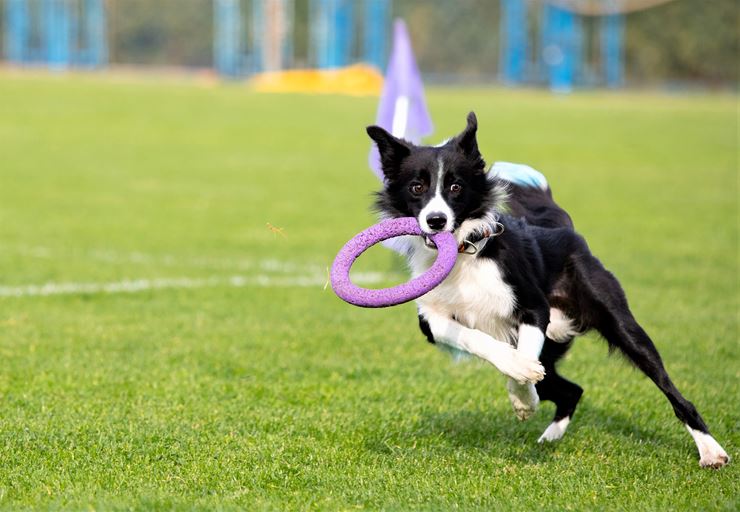
Lure coursing is an exhilarating dog sport that taps into a canine's natural hunting instincts. In lure coursing competitions, dogs chase after a mechanized lure that resembles a small animal. The lure is attached to a pulley system and travels at high speeds, simulating the movement of prey. Dogs are evaluated on their enthusiasm, speed, agility, and ability to follow the lure.
There are different types of lure coursing competitions, including field trials and lure field tests. Field trials are typically for sighthound breeds like Greyhounds and Salukis, while lure field tests are open to a wider range of dog breeds.
Lure coursing is an ideal sport for dogs with a strong prey drive, as it allows them to engage in their instinctual behavior in a controlled and safe environment. It provides both mental and physical stimulation for dogs, keeping them active and fulfilled.
When considering lure coursing for your dog, it is important to take into account their breed suitability and any specific training requirements. Some breeds naturally excel in lure coursing, while others may require additional training to develop the necessary skills.
Overall, lure coursing offers an exciting and challenging dog sport that allows dogs to unleash their hunting instincts while also enjoying the thrill of the chase.
Unleashing the Hunting Instinct: Lure Coursing for Dogs

Lure coursing is a thrilling dog sport that taps into a dog's natural hunting instincts. It allows them to showcase their incredible speed and agility while chasing a mechanically operated lure. This sport replicates the traditional hunting technique of pursuing small game in an open field. Lure coursing involves a course laid out with twists, turns, and obstacles, designed to simulate the movement of prey.
Different types of lure coursing include straight racing, oval track racing, and coursing ability tests. Each type varies in terms of course layout and length, but they all provide an opportunity for dogs to showcase their athleticism and prey drive.
Lure coursing is suitable for sighthound breeds like Greyhounds, Afghan Hounds, and Salukis, as their natural instinct and physical capabilities align perfectly with this sport. However, other breeds and mixed-breed dogs can also participate and enjoy this activity.
Participating in lure coursing not only provides physical exercise for dogs but also mental stimulation and a chance to express their hunting instinct. It allows them to engage in a sport that is deeply ingrained in their genetic makeup. So, whether your dog is a sighthound or a different breed, lure coursing is a fantastic way to keep them active and focused on something they truly love.
Types of Lure Coursing and Breed Suitability

When it comes to lure coursing, there are different types of events that cater to different breeds and sizes of dogs. The two main types of lure coursing are Open Field Coursing (OFC) and Coursing Ability Tests (CAT).
Open Field Coursing is typically reserved for sighthounds such as Greyhounds, Whippets, and Salukis. These breeds excel in chasing and catching prey, making them perfect for this type of coursing. On the other hand, Coursing Ability Tests are open to all breeds and mixed breeds. This allows dogs with a strong prey drive, regardless of breed, to participate and showcase their skills in chasing the lure.
When deciding which type of lure coursing is suitable for your dog, it's important to consider their breed traits and natural abilities. Some breeds may have a higher inclination towards chasing and coursing, while others may not be as interested. Additionally, considering your dog's size and energy levels is also crucial in determining their suitability for lure coursing events. It's always a good idea to consult with breed experts or trainers to determine the best fit for your dog.
Conclusion
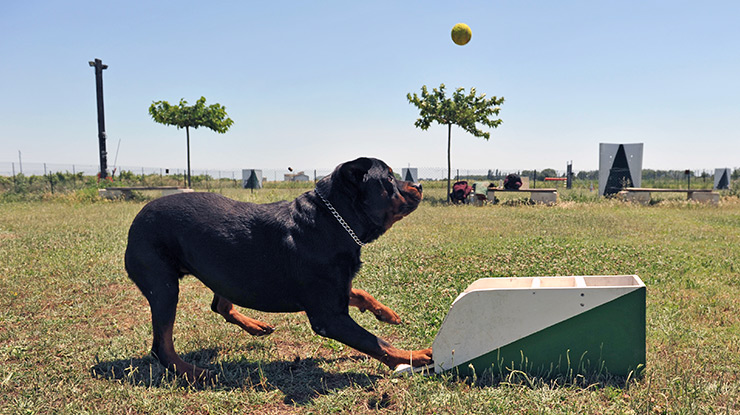
Conclusion
In conclusion, dog sports offer a wide range of opportunities for dogs and their owners to engage in exciting and fulfilling activities together. Whether it's the agility of navigating through an obstacle course, the precision of obedience trials, the thrill of catching a flying disc, the exhilarating jumps of dock diving, the fusion of obedience and agility in rally obedience, or the unleashed hunting instinct in lure coursing, there is a dog sport for every dog and their unique abilities.
Engaging in dog sports not only provides physical exercise and mental stimulation for dogs but also strengthens the bond between dog and owner. It fosters teamwork, enhances communication, and promotes a sense of accomplishment for both partners.
If you're considering participating in a dog sport, take the time to research the different options available and find one that aligns with your dog's natural abilities and your own interests. Remember, it's important to always prioritize safety and ensure proper training techniques and equipment are used. So get out there and uncover the joys of dog sports with your furry best friend.
Frequently Asked Questions about Dog Sports
- Are dog sports suitable for all breeds of dogs?
While dog sports are accessible and enjoyable for many breeds, it's important to consider the physical capabilities and natural instincts of your specific dog. Certain breeds may excel in certain sports, while others may struggle. It's essential to research the requirements and suitability for your dog's breed and consult with experts if needed. - Can I participate in dog sports if my dog is not a purebred?
Yes, mixed breed dogs are often welcome and permitted to participate in dog sports. Many sports prioritize performance and ability over breed. As long as your dog meets the necessary requirements and has the appropriate temperament and drive for the sport, they can enjoy the thrill of competition. - How can I get started in dog sports?
To get started in dog sports, it's recommended to find local clubs or organizations that offer training classes and competitions in your chosen sport. A professional trainer can guide you on proper techniques, equipment, and rules. Practice, patience, and consistency are key to success in dog sports. - Can older dogs participate in dog sports?
Older dogs can definitely participate in some dog sports. It's important to consider their physical condition and any limitations they may have. Consult with your veterinarian to ensure that your older dog is fit for the specific sport and take appropriate measures to prevent injury or strain. - Are dog sports only for competitive purposes?
While many people participate in dog sports for the thrill of competition, it's not the sole purpose. Dog sports are also a fantastic way to bond with your dog, provide mental and physical exercise, and enhance obedience and agility skills. They can be a fun activity for both you and your furry companion, regardless of the competitive aspect.
Choosing the Right Dog Sport for You and Your Dog

When it comes to choosing the right dog sport for you and your furry friend, there are a few factors to consider. First and foremost, think about your dog's breed and individual personality. Some sports, like agility and flyball, are better suited for high-energy breeds, while obedience and rally obedience can be enjoyed by a wide variety of dogs.
Next, consider your own interests and preferences. Are you looking for a fast-paced, adrenaline-packed sport like disc dog or dock diving? Or do you prefer the precision and structure of obedience trials? Think about what activities you enjoy and what qualities you want to bring out in your dog.
Lastly, take into account your lifestyle and availability. Some sports require frequent practice sessions, while others may only require occasional participation. Find a sport that fits into your schedule and is sustainable in the long term.
By considering these factors and understanding the different facets of various dog sports, you can make an informed decision that will ensure both you and your dog have a fantastic time participating in the chosen sport.
Frequently Asked Questions about Dog Sports

Frequently Asked Questions about Dog Sports:
- What is the best dog sport for my dog?
The best dog sport for your dog depends on their breed, physical abilities, and temperament. Some breeds excel in agility, while others may thrive in obedience or disc dog competitions. Consider your dog's strengths and interests when choosing a sport. - How can I get started in dog sports?
To get started in dog sports, research local clubs or organizations that offer training classes or competitions. Attend a few events to get a feel for the sport and talk to experienced handlers for guidance. - Do I need any special equipment for dog sports?
The equipment needed for dog sports varies depending on the specific sport. For agility, you may need jumps, tunnels, and weave poles. Flyball requires a box launcher and a set of hurdles. Obedience may require a collar and leash. Consult with trainers or experienced handlers to determine the necessary equipment for your chosen sport. - Is my dog too old to participate in dog sports?
Age is not necessarily a barrier to participation in dog sports. While some sports may have age restrictions for competitive purposes, older dogs can still enjoy training and participating in non-competitive events. Consult with your veterinarian to ensure your dog is physically fit for the chosen sport. - Can I participate in dog sports if I don't have a purebred dog?
Dog sports are open to all breeds, including mixed breeds. Many organizations have categories or divisions specifically for mixed breed dogs. As long as your dog meets the requirements for participation, you can enjoy the excitement of dog sports regardless of breed.
Remember to always prioritize your dog's well-being and enjoyment when participating in dog sports. Consult with trainers, veterinarians, and experienced handlers to ensure you and your dog have a positive and fulfilling experience.




0 Comments